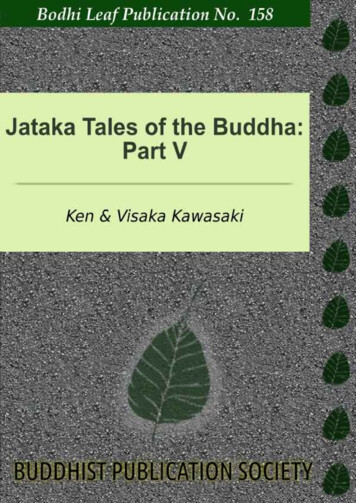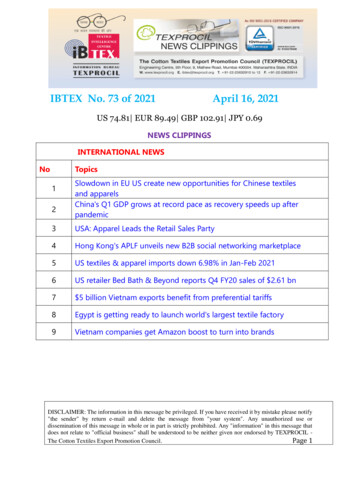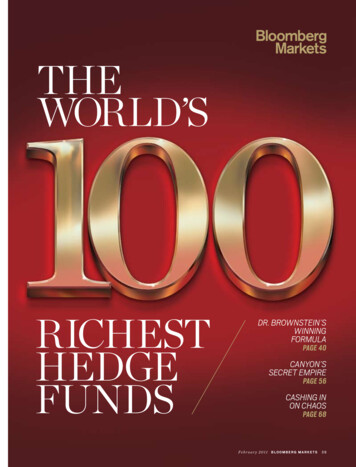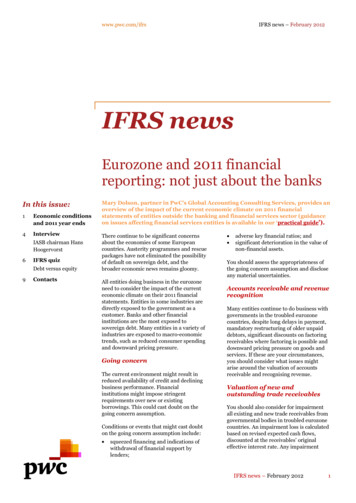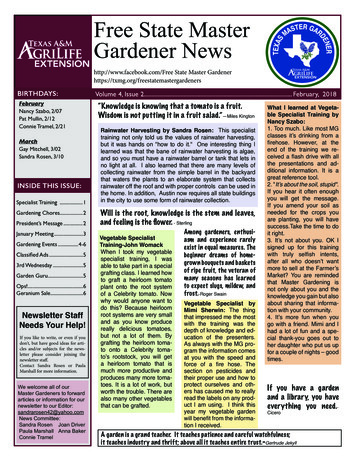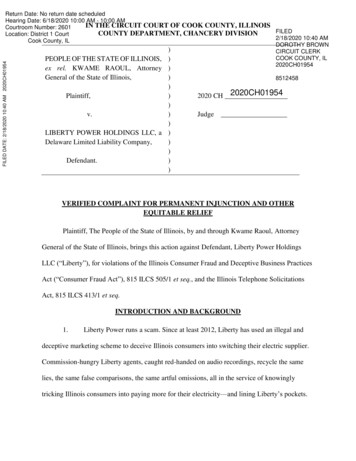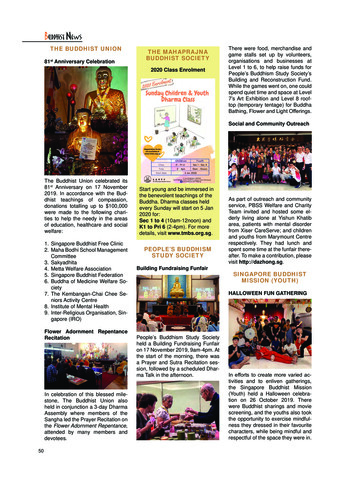
Transcription
Buddhist NewsTHE BUDDHIST UNION81st Anniversary CelebrationTHE MAHAPRAJNABUDDHIST SOCIETY2020 Class EnrolmentThere were food, merchandise andgame stalls set up by volunteers,organisations and businesses atLevel 1 to 6, to help raise funds forPeople’s Buddhism Study Society’sBuilding and Reconstruction Fund.While the games went on, one couldspend quiet time and space at Level7’s Art Exhibition and Level 8 rooftop (temporary tentage) for BuddhaBathing, Flower and Light Offerings.Social and Community OutreachThe Buddhist Union celebrated its81st Anniversary on 17 November2019. In accordance with the Buddhist teachings of compassion,donations totalling up to 100,000were made to the following charities to help the needy in the areasof education, healthcare and socialwelfare:1. Singapore Buddhist Free Clinic2. Maha Bodhi School ManagementCommittee3. Sakyadhita4. Metta Welfare Association5. Singapore Buddhist Federation6. Buddha of Medicine Welfare Society7. The Kembangan-Chai Chee Seniors Activity Centre8. Institute of Mental Health9. Inter-Religious Organisation, Singapore (IRO)Flower Adornment RepentanceRecitationIn celebration of this blessed milestone, The Buddhist Union alsoheld in conjunction a 3-day DharmaAssembly where members of theSangha led the Prayer Recitation onthe Flower Adornment Repentance,attended by many members anddevotees.Start young and be immersed inthe benevolent teachings of theBuddha. Dharma classes heldevery Sunday will start on 5 Jan2020 for:Sec 1 to 4 (10am-12noon) andK1 to Pri 6 (2-4pm). For moredetails, visit www.tmbs.org.sg.PEOPLE’S BUDDHISMSTUDY SOCIETYBuilding Fundraising FunfairAs part of outreach and communityservice, PBSS Welfare and CharityTeam invited and hosted some elderly living alone at Yishun Khatibarea, patients with mental disorderfrom Xiser CareServe; and childrenand youths from Marymount Centrerespectively. They had lunch andspent some time at the funfair thereafter. To make a contribution, pleasevisit http://dazhong.sg.SINGAPORE BUDDHISTMISSION (YOUTH)HALLOWEEN FUN GATHERINGPeople’s Buddhism Study Societyheld a Building Fundraising Funfairon 17 November 2019, 9am-4pm. Atthe start of the morning, there wasa Prayer and Sutra Recitation session, followed by a scheduled Dharma Talk in the afternoon.In efforts to create more varied activities and to enliven gatherings,the Singapore Buddhist Mission(Youth) held a Halloween celebration on 26 October 2019. Therewere Buddhist sharings and moviescreening, and the youths also tookthe opportunity to exercise mindfulness they dressed in their favouritecharacters, while being mindful andrespectful of the space they were in.50p50 - News.indd 502019/11/22 15:11:34
EVENTSDRIKUNG KAGYU (SINGAPORE) OM CENTREMILAREPA ��启发。其他人对他很感兴趣。Tibetans revere him.Buddhists are inspired by him.Others are simply intrigued by him.Jetsun Milarepa is an accomplished 11th century Buddhist practitioner andpoet, venerated by all Tibetan Buddhist Schools for his religious dedicationand spiritual realisation. Perhaps best known through his biography, TheLife of Milarepa, the stories of Milarepa’s miracles have captivated theimagination of readers for centuries. These miracles were performed not toimpress, but to challenge our perception of reality and to turn our minds toseek answers to life’s many questions.For the first time in Singapore, Drikung Kagyu (Singapore) Om Centre heldthe Milarepa Exhibition from 26 October to 3 November 2019 at NanyangPoh Leng Hui Kuan, 10am to 6pm daily. Carefully curated by Lama Dawa,the Spiritual Advisor of Drikung Kagyu (S) Om Centre, Singapore is the thirdstop of this exhibition tour. The exhibition made its debut in Bodhgaya, Indiaand was soon followed by a second successful reception in Taipei, Taiwan.On the day of its opening here in Singapore, Member of Parliament FatimahLateef graced the elaborate opening ceremony and delivered the openingaddress. Many Venerables of all three Buddhist traditions from variouscentres and temples also attended to lend their support, and respectiverepresentatives also delivered their congratulatory speeches as well.This unprecedented exhibition showcasedthoughtfully curated exhibits – artworks, ancientartefacts, records and pictures of places, whereMilarepa meditated during his lifetime and even alife-sized installation of the cave. Amongst themare rare photographs of his birthplace, asceticpractice, enlightenment and Mahaparinirvanasites, providing a rare insight and authenticperspective of the life and accomplishments ofThese pieces of clothes belonged to Jetsun Milarepa. They camefrom the sacred mountain Lapchi and were placed in the treasurechest from Lapchi.Milarepa. During the exhibition,visitors were guided by volunteerexhibition guides where detailedexplanations of each exhibit’sorigin and significance were given,transporting visitors to the worldwhere the Buddhist Master Milarepaonce lived. Before the exhibitionlaunch, For You Informationinterviewed Lama Dawa to findout more about the inspiration,motivation, concept and aspirationsfor this exhibition.Planting the Seed of the DharmaWhen asked why Milarepa waschosen as the central figure ofthe exhibition, Lama Dawa didnot hesitate and candidly replied,“I was intrigued, and at the sametime amazed by all the stories Iheard about Milarepa when I wasyounger. My mother would tell usstories of Milarepa, and it was notonly her who would share thoseamazing stories. In fact, Milarepawas a commonly revered householdname.” Lama Dawa also shared thatas he grew older, his initial intrigueturned into curiousity, and later aweand respect when he learnt aboutthe life story of Milarepa and howhe became one of Tibet's mostfamous and respected yogis andpoets, serving as an example forthe Buddhist life. Milarepa was alsoa student of Marpa Lotsawa, andFor You Information 佛友资讯p51- 53 EVENTS.indd 51512019/11/22 15:12:24
a major figure in the history of theKagyu School of Tibetan Buddhism,and thus Lama Dawa always hadthe thought of wanting to spreadMilarepa's life story as widely aspossible. However, what strikespeople most about Milarepa is notjust how he was an accomplishedpractitioner and siddha1, capable ofastonishing feats but, the poignantprocess of how he became one.Through Lama Dawa’s interactionwith disciples and the lay community,he had the idea of putting together anexhibition on Milarepa consideringhow most people these dayslead a busy, hectic life. Where anexhibition condensing the essenceof Milarepa’s life story, practice andparinirvana would enable all visitorsto learn more about the GreatYogi Milarepa and his remarkableachievements in less time, andreceive the immeasurable benefitsof knowing about this most famousYogi of Tibet.There were scheduled sessions where LamaDawa personally gave the visitors a guided tourof the exhibition.InspiringMotivationPractitionersforThe multi-story tower (9-storey) built by Milarepa, at Lhodrag.Though born into a prosperousfamily western Tibet, Milarepalater had a tumultuous childhoodaccording to The Life of Milarepa2,when his family fell from grace after the passing of his father. Things changedtotally for Milarepa when his aunt and uncle usurped the estate his late dadleft for the family and deprived his surviving mum, brother and him of thefamily's wealth. Angered by the betrayal, his mum encouraged him to learnsorcery and to take revenge, which he eventually did, causing the death of35 people at his cousin’s wedding.Overcome by sorrow and regret, Milarepa went to seek teachings fromMarpa3, the Translator. Before Marpa would teach Milarepa, he had himundergo many tormenting trials, such as requesting him to build, demolishand re-build three towers consecutively. Milarepa was asked to build one finalmulti-story tower (9-storey) at Lhodrag, which still stands today. Eventually,Marpa accepted him, explaining that the trials were skilful means to purifyMilarepa's negative karma. In subsequently years, Marpa transmitted Tantricinitiations and instructions to Milarepa, including "yogic heat" (tummo)and “aural transmissions” (snyan rgyud), and Mahamudra. Under Marpa’sinstruction, Milarepa practised solitary meditation in caves and mountainretreats, which, according to the biography, after many years of practiceresulted in "a deep experiential realisation about the true nature of reality".Thereafter, he lived as a fully realised yogi, and eventually forgave his aunt,who caused the misfortune of his family.This is what Lama Dawa wants to convey through the exhibition – the abilityto transform from a “mere mortal” who has experienced loss, betrayal andpain; and burdened by anger, vengeance and negative karma of killing, intoan enlightened being. He explained that Milarepa’s example is inspiration topersevere in one's practice – from the generation stage to completion stagein achieving Mahamudra, “the spontaneous realisation of the most profoundnature of mind.” This portrays the "the rapid method of the Tantric path", inwhich liberation is gained in one lifetime.Reflecting ImpermanenceThe Milarepa Exhibition was a photo exhibition, that narrated Milarepa’s lifejourney in a clockwise direction, depicting how Buddhism was understoodand practised in Tibet in the fifteenth century as well as the ticking hands ofthe clock of impermanence. The photos were also arranged in chronologicalorder, bringing visitors back in time, to the sacred places connected toMilarepa. This included sites where Milarepa performed miraculous acts.The iconography were presented in the stylistic elements from the biographyof Gautama Buddha to portray Milarepa effectively as a Tibetan Buddha,"born and enlightened in Tibet, without going to India or receiving the directinstructions of an Indian master”.And upon completing the tour of the exhibition, it was clear that despiteall the references to the stages of generation and completion, and all ofMilarepa’s meditation on the channels, winds, and drops, as he approachesthe achievement of Buddhahood, his instructions to those he encounterscontinue to embody the core essence of Buddhist teachings: “Impermanence,the sufferings of saṃsā̄ra, the certainty of death and the uncertainty of itsarrival, the frightful rebirth that is the direct result of our benighted deeds.”Milarepa’s life story exemplified that despite having committed gravemistakes, “even one who has murdered thirty-five innocent people can,through devotion to the teacher and the practice of the path, transform52p51- 53 EVENTS.indd 522019/11/22 15:12:46
oneself into a perfect Buddha, where the Dharma is present everywhereone turns, where “everything in the outer world appears as scriptures,” andwhere the profane is sacred. Thus, these two parallel worlds, a profane worldand a sacred world, which are ultimately one, shows that the world itself issacred.Ancient manuscripts, pictures and Mila (Me Thub Ma) a Milarepastatue made by Lapchi Namkha Gyaltsen in early 15th century, thatsurvived a fire in the temple unscathed. ‘Me Thub’ means ‘indestructible by fire’.In the centre of the exhibition hall lies an elevated platform showcasingancient artefacts, manuscripts of The Life Story of Tilopa, The Life Storyof Naropa, The Life Story of Marpa and The Life Story of Gompopa, andThe Life Story of Milarepa etc, reminding visitors of the deep guru-discipleconnections.At the four corners of the platform, marking the four cardinal directions arefour pillars; depicting the prophecy Marpa had about Milarepa in The Life ofMilarepa, when he interprets Milarepa’s famous dream of the four pillars,each surmounted by a different animal: a lion, a tigress, a garuda, and avulture. Marpa identifies the vulture that sits atop the pillar in the north to beMilarepa, with the many small birds that fly above it his disciples.I dreamt to the north a great pillar was raised.I dreamt high on the pillar a vulture hovered.I dreamt the vulture’s plume fanned open wide.I dreamt the vulture’s aerie was perched on a crag.I dreamt that unto the vulture a sole chick was born.I dreamt that the sky was filled with small birds.I dreamt that its eyes gazed toward the heavens.I dreamt that the vulture flew off into space.I recount my dream to the lama, the three-times buddhas.The small birds filling the sky – Isthe spread of the Kagyu teachings.Its eyes gazing toward theheavens – Are his waving goodbye to life’s round.The vulture’s flying off throughspace – Is his journey intoliberation’s sanctum.The dream of the north is notinauspicious, what an excellentdream it is,Such have I told to you all gatheredhere.As for your old father, my work iscompleted.Now, you disciples, your hour hascome.If you pay attention to the words ofthis old man now,The practice lineage teachings willspread in the future.Going Beyond the ExhibitionIt is the sincere wish of theorganisers and members of DrikungKagyu (Singapore) Om Centre thatthe life and accomplishments ofBuddhist Master Jetsun Milerapado not remain just as a story inour minds, but an inspiration in ourhearts as we strive to attain final,lasting liberation.The great pillar raised to the north – Is Milarepa of Gungtang.The vulture hovering high on the pillar – Means his character is like that ofa vulture.The vulture’s plume fanned open wide – Is his reception of the auraltransmission instructions.The vulture’s aerie perched high on a crag – Means his life force will befirmer than rock.The sole chick born unto the vulture – Is his one unrivaled son who willappear.1Siddha a term that means “one who is accomplished”, referring to perfected masters who have achieved a high degree of physical as well as spiritualperfection or enlightenment. Siddha may also refer to one who has attained a siddhi, paranormal capabilities.2The Life of Milarepa, translated by Andrew Quintman, Penguin Classics, 2010.3Marpa, the Translator (Marpa Lotsāwa) was a Tibetan Buddhist teacher credited with the transmission of many Vajrayana teachings from India,includi
initiations and instructions to Milarepa, including "yogic heat" (tummo) and “aural transmissions” (snyan rgyud), and . Mahamudra. Under Marpa’s instruction, Milarepa practised solitary meditation in caves and mountain retreats, which, according to the biography, after many years of practice resulted in "a deep experiential realisation about the true nature of reality". Thereafter, he .
